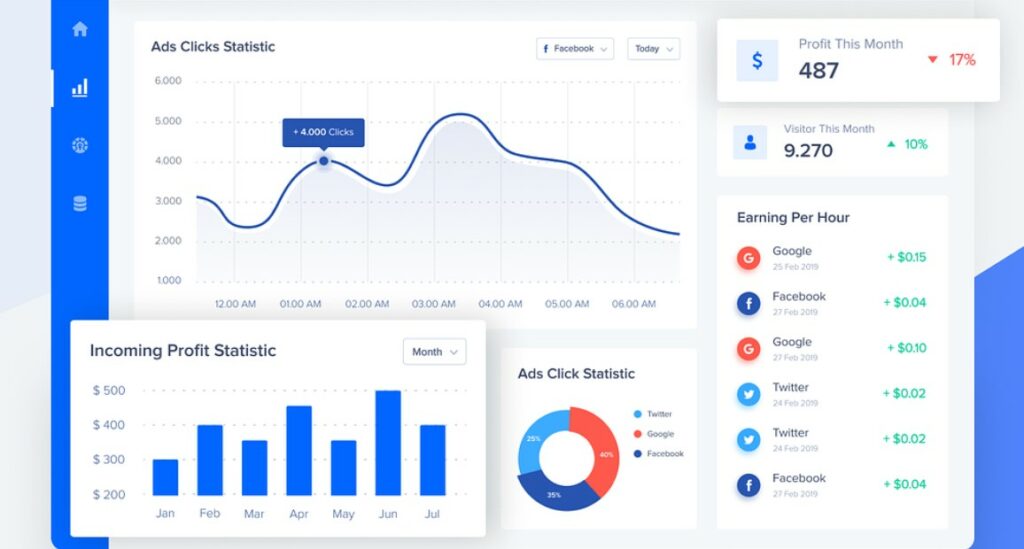Understanding the power of data analytics:
In today’s digital landscape, data analytics has become a strategic imperative for businesses. It revolutionizes operations by collecting, analyzing, and interpreting vast amounts of information to uncover valuable insights and drive informed decision-making. By harnessing the power of data analytics, companies can unlock hidden patterns, trends, and correlations that fuel growth and elevate customer experiences.
The pivotal role of data analytics in the digital era:
As customers increasingly engage with brands through online channels, understanding their behavior and preferences is paramount. This is where data analytics takes center stage. It empowers businesses to track customer interactions across various touchpoints like websites, social media platforms, mobile apps, and more. By delving into this wealth of customer-generated data or “digital footprints,” organizations gain profound insights into their needs and expectations.
Transforming customer experience through data analytics:
Data analytics has the power to revolutionize customer-brand interactions. By using predictive modeling and machine learning, businesses can anticipate needs and provide personalized solutions. They analyze feedback and behavior patterns to identify user experience pain points. Armed with these insights, companies optimize products or services to tackle specific issues head-on. With data-driven strategies based on real-time consumer insights, organizations consistently exceed expectations. Ultimately, data analytics empowers businesses to make strategic decisions that enhance performance and customer satisfaction levels.
Click here to learn all about digital customer experience strategies!
The Intersection of Data Analytics and Customer Experience
In today’s digital landscape, customer experience has emerged as a game-changer for businesses. Customers now demand personalized and seamless interactions across all digital touchpoints – websites, mobile apps, and social media platforms. And this is precisely where data analytics takes center stage. Data analytics is the strategic process of collecting, analyzing, and interpreting vast amounts of information to uncover valuable insights that drive business decisions. When applied to customer experience management, data analytics empowers businesses to truly understand their customers and tailor their offerings accordingly.
The significance of customer experience cannot be emphasized enough. Extensive research reveals that positive experiences throughout the customer journey foster brand loyalty. By harnessing the power of data analytics, businesses can elevate these experiences in remarkable ways:
- Personalization: With data analytics at your disposal, you gain access to invaluable knowledge about individual customers’ preferences, behaviors, and purchase history. Armed with this information, you can create highly personalized offers and recommendations tailored specifically for each unique customer.
- Anticipating Customer Needs: Predictive analytics emerges as a formidable tool within the realm of data analysis techniques. By scrutinizing historical patterns and trends in customer behavior meticulously, businesses can anticipate future needs or desires even before customers themselves realize them.
- Seamless Omnichannel Experiences: In today’s digitally-driven world, where customers engage with brands through multiple channels simultaneously (think online shopping while scrolling through social media), delivering a seamless omnichannel experience becomes paramount for success. Data analytics helps identify pain points along the entire customer journey across various touchpoints so that necessary improvements can be made swiftly.
Real-world success stories abound when it comes to leveraging data analytics to enhance customer experiences:
- Amazon employs sophisticated algorithms fueled by past purchases and browsing behavior to recommend products tailored exclusively for each user.
- Netflix capitalizes on user viewing habits alongside cutting-edge machine learning algorithms to offer personalized movie recommendations.
- Starbucks maximizes its mobile app in conjunction with location-based services to provide customers with tailored promotions and rewards.
By harnessing the power of data analytics, businesses gain invaluable insights into their customers’ preferences, behaviors, and needs. Armed with this knowledge, they can create unforgettable experiences that deeply resonate with their target audience – ultimately leading to heightened customer satisfaction and unwavering loyalty. In the next section, we will delve deeper into the key components of data analytics for effective customer experience management. Stay tuned!

Implementing Data Analytics in Your Business
To truly revolutionize the customer experience in a digital environment, businesses must master the art of implementing data analytics. By following these expert steps, you can unlock the full potential of data analytics and take your business to new heights:
- Understanding Customer Behavior Through Data Analytics:
- Harness cutting-edge data analytics tools and techniques to gain deep insights into customer behavior patterns.
- Dive into customer interactions, preferences, and purchase history to uncover hidden trends and make well-informed decisions.
- Predictive Analytics for Anticipating Customer Needs:
- Embrace predictive analytics models that allow you to anticipate future customer needs and preferences.
- Combine historical data with powerful machine learning algorithms to forecast potential outcomes and tailor your offerings accordingly.
- Personalization and Customization Through Data Analytics:
- Utilize the remarkable capabilities of data analytics to deliver personalized experiences that leave a lasting impact on customers.
- Segment your customers based on their unique preferences, demographics, or past behaviors, enabling you to launch targeted marketing campaigns or provide personalized product recommendations.
- Choosing the Right Data Analytics Tools and Platforms:
- Evaluate an array of top-notch data analytics tools available in today’s market that align with your specific business goals.
- Consider factors such as scalability, ease of use, seamless integration with existing systems, robust security measures, and cost-effectiveness when selecting a tool or platform.
- Training Your Team for Data-Driven Decision-Making Process:
- Empower your team members through comprehensive training programs focused on interpreting and utilizing invaluable data-driven insights effectively.
- Foster a culture of continuous learning by encouraging employees at all levels within your organization to embrace the decision-making process guided by solid data analysis.
By seamlessly integrating these strategies into every facet of your business operations, you will harness the true power of data analytics while enhancing every aspect of the customer journey in the digital realm. Remember, successful implementation requires not only technological advancements but also a steadfast commitment from your entire organization to leverage the invaluable insights derived from analyzing vast amounts of customer information. Stay tuned for Section 5: Measuring the Impact of Data Analytics on Customer Experience, where we will delve into key performance indicators and methods to measure customer satisfaction and engagement.
Future Trends in Data Analytics and Customer Experience
Enhancing the Customer Experience in a Digital Environment: The Power of Data Analytics
As experts in the field, we understand the importance of leveraging data analytics to enhance customer experiences in a digital environment. By utilizing this powerful tool, businesses can gain valuable insights and make informed decisions that will ultimately drive success.
To truly understand the impact of data analytics on customer experience, it is crucial for business owners and managers to measure its effectiveness. This allows you to assess how well your strategies are working and make necessary adjustments to improve customer satisfaction and engagement.
Here are some key performance indicators (KPIs) that can help you measure the impact of data analytics:
- Customer Satisfaction: At the heart of any successful business is satisfied customers. By measuring customer satisfaction through surveys, feedback forms, or online reviews, you can identify areas where improvements need to be made. This invaluable information enables you to enhance the overall customer experience by addressing pain points and meeting their needs more effectively.
- Customer Engagement: Active involvement from customers is a strong indicator of their connection with your brand or product. Tracking metrics such as website visits, social media interactions, email open rates, and click-through rates provides insights into how well your data-driven strategies resonate with customers compared to industry benchmarks. This knowledge empowers you to refine your approach and create meaningful engagements that foster loyalty.
- Conversion Rates: Ultimately, driving desired actions from customers is essential for business growth. Whether it’s making a purchase, signing up for a newsletter, or downloading an app – monitoring conversion rates offers valuable insights into how effective your data analytics initiatives are at influencing customer behavior. Armed with this information, you can optimize strategies accordingly for maximum impact.

Now let’s explore real-life examples showcasing the successful implementation of data analytics in enhancing customer experiences:
- Case Study 1: Company X utilized predictive analytics to analyze browsing patterns and purchase history among their customers on their e-commerce platform. Through personalized product recommendations, they witnessed a significant increase in average order value and repeat purchases. This demonstrates the power of data analytics in delivering tailored experiences that drive customer loyalty.
- Case Study 2: Company Y employed sentiment analysis using natural language processing techniques to analyze social media conversations about their brand. By swiftly identifying negative sentiments and addressing customer concerns, they were able to improve brand perception and foster increased customer loyalty. This exemplifies how data analytics can help businesses proactively manage their online reputation.
In conclusion, measuring the impact of data analytics on customer experience is vital for optimizing strategies and ensuring a satisfying journey for your customers. By tracking key performance indicators such as customer satisfaction, engagement, and conversion rates, you can make informed decisions that will ultimately lead to business growth and success. Embrace the power of data analytics today to transform your digital environment into one that truly enhances the overall customer experience.

